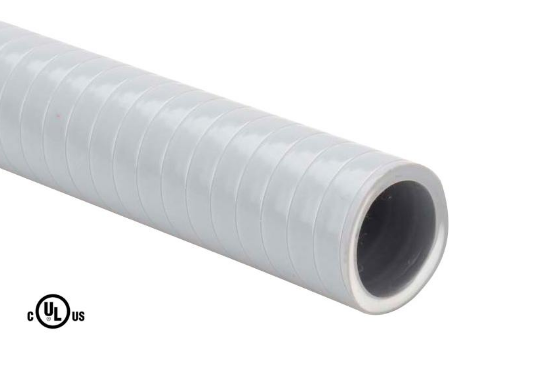Nov. 15, 2023
Looking to safeguard and direct electrical cables?
A conduit serves as a protective tube specifically designed to house electrical wiring in residential, commercial, and industrial structures. Its primary function revolves around shielding enclosed wires from potential hazards like fire, mechanical impact, water, and corrosion.
Conduits generally fall into two categories: metallic and non-metallic.
In this article, we'll delve deeper into non-metallic conduits, exploring their various types, applications, and advantages.
What exactly are non-metallic conduits?
Non-metallic conduits are commonly crafted from PVC (polyvinyl chloride), a widely utilized synthetic plastic polymer globally.
For applications situated above ground, these conduits must possess attributes such as flame-retardance, durability, and resistance to environmental factors like heat, sunlight, and low temperatures.
Unlike their metallic counterparts, often reserved for safeguarding delicate circuits, non-metallic conduits find versatility in their ability to be deployed both above and below ground, accommodating multiple or parallel run configurations.

Liquid Tight Non-Metallic Flexible Conduit - PLFNCB Series
Types of non-metal conduit
Different variations of non-metal conduits exist, available in rigid and flexible forms, each tailored to offer distinct properties and advantages catering to diverse applications:
1. Rigid Non-Metallic Conduit (RNC):
RNC stands as a smooth-walled, non-metallic tubing typically manufactured from PVC. Designed for wet locations, it remains unthreaded and provides a sturdy, durable option for various settings.
2. Electrical Non-Metallic Tubing (ENT):
ENT represents a thin-walled, corrugated tubing known for its moisture-resistant and flame-retardant qualities. Its flexibility and pliability make it an ideal choice for concealing wires within walls while ensuring safety.
3. Liquid-Tight Flexible Non-Metallic Conduit (LFNC):
LFNC, constructed from PVC with smooth inner and outer surfaces, finds extensive use in HVAC systems, power plants, and various indoor and outdoor hazardous environments. Its liquid-tight design offers protection against moisture, making it a reliable choice in such settings.
4 reasons to use non-metallic conduits
Electrical conduit systems are critical components in various industrial, commercial, and residential settings. Among the options available, non-metallic conduits stand out for several compelling reasons. In this comprehensive guide, we'll delve into the myriad benefits of utilizing non-metallic conduits in electrical installations, elucidating why they are gaining prominence over traditional metallic conduits.
1. Unparalleled Resistance to Moisture
One of the primary advantages that non-metallic conduits offer is their exceptional resistance to moisture. Designed to provide robust protection against moisture ingress, these conduits are ideal for underground applications and areas susceptible to dampness in industrial and commercial environments. Unlike their metal counterparts, non-metallic conduits effectively prevent water, oil, and dirt from permeating, ensuring the safety and longevity of the enclosed wiring systems.
2. Superior Corrosion Resistance
In contrast to metal conduits, non-metallic conduits exhibit heightened resistance to corrosive elements. Materials such as PVC (Polyvinyl Chloride) and polypropylene, commonly used in non-metallic conduits, display remarkable durability when exposed to saltwater and various chemicals. This corrosion resistance attribute positions them as an optimal choice for underground installations across diverse settings, including domestic, commercial, and industrial applications.
3. Simplified Installation Process
Non-metallic flexible conduits offer unparalleled ease of installation, making them a preferred choice for many electrical projects. Their lightweight design, coupled with innovative features like split conduits, facilitates effortless cable insertion. This feature proves advantageous, especially in scenarios requiring swift replacement of damaged or faulty cables, saving both time and effort during maintenance operations.
4. Cost-Effectiveness
While various conduits are competitively priced, non-metallic conduits often emerge as the most cost-effective option. Their affordability makes them an attractive choice for individuals and organizations operating within budget constraints. Whether protecting electrical cables above or below ground, non-metallic conduits provide a cost-efficient solution without compromising on quality or reliability.
It's noteworthy that non-metallic conduits are available in different coil lengths, ranging from 25 meters to 100 meters. Optimal utilization involves assessing the required length for a specific application, enabling cost-effective purchases while ensuring seamless installation.
Conclusion
In summary, the compelling advantages of non-metallic conduits, such as moisture resistance, corrosion resistance, ease of installation, and cost-effectiveness, position them as indispensable components in modern electrical installations. Their versatility, coupled with the ability to mitigate environmental challenges, makes them a preferred choice for diverse electrical infrastructure requirements.
Harness the benefits of non-metallic conduits to safeguard your electrical systems and optimize efficiency in various settings, from residential homes to large-scale industrial complexes.

















